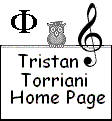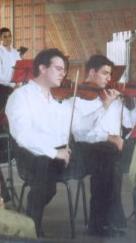 Violin & Viola
Violin & Viola
 Violin & Viola
Violin & Viola
 Short
4th finger page
Short
4th finger page
|
1) The Problem Oops! Almost didn't catch that note! In case you have a short fourth finger (see photos below) and are studying the violin or viola, the link below may be of interest. It is important to note that the shortness comes not from the finger itself, but from the bone within the hand. Try https://www.violinist.com/search.cfm?q=short%20pinky%20
2) Two Possible Solutions (try at your own risk!) As far as left hand technique is concerned, there are two major modifications of standard technique that need to be adopted. The first is to place the thumb rather low behind and under the neck of the violin so as to allow the fourth finger to have maximal reach. This is done by all players when they play in very high positions. A suggestion is to work downwards by crawling (R. Ricci) from the highest positions to first position, but maintaining that basic hand shape. The thumb should be kept low and not wrap around the neck as is in standard technique, although it may be have to move up briefly while shifting around. This low placement of the thumb makes the use of a shoulder rest rather important for stable bowing, but this does not mean that the left hand cannot or should not support the weight of the instrument. On the contrary, I prefer to avoid chin contact with the instrument as much as possible. This page on Anne-Sophie Mutter's left hand technique shows her thumb position. This is the closest approximation to what I am suggesting that I could find among players with normal hands. Playing with a low thumb allows the base joint (or knuckle) of the 4th finger to reach farther without straining. It is particularly important to look out for excessive thumb counterpressure (of which fatigue is an indication and warning signal). The left elbow may also have to be brought further in. The second modification of standard technique is twisting the index finger sideways, as Kim Walters demonstrates in her video. Joy Lee's suggestion to raise the index finger is also helpful. This helps us to realize that when the pinky is short the index finger becomes proportionally too long and hence needs to be repositioned. Another way of describe the short pinky problem would be to call it "the long index finger problem". 3) Instrument-related solution The thinner and narrower the neck, the easier it is to reach out with the 4th finger. I would say that the neck should be as thin as possible, provided it can still safely withstand the tension of the strings. A luthier can help you in this. 4) A few observations on short 4th finger It is not a significant issue for the bow hand. Some players release the 4th finger from the stick to play fast sautillé, for example. But the Franco-Belgian bow hold will look slightly different because the index finger is proportionally too long. Left hand extensions are not impossible but must be examined carefully. Simon Fischer's advice on building the left hand on the fourth finger is of paramount importance. The study of double stops (3rds, 6ths, 8vs, 10ths) is very important to sort these issues out. In higher positions, the short pinky creates imbalances for fingered octaves, fingered thirds and so on. This may sometimes require 1+3 fingerings throughout, instead of alternating 1+3, 2+4, etc. Regarding role models (a question raised on www.violinist.com), the only professional I know about who has this kind of hand is conductor Lim Kek-Tjiang, the so-called "Karajan of Asia". The issue whether a person who has this kind of hand should give up any hope for a career as a soloist (!) is hard to answer because it depends on so many things. Sarasate had small hands and never played the Brahms concerto in public. Nevertheless he was a great 19th century violinist-composer. But there is no reason why somebody with a short 4th finger cannot become a very good player. To be a violinist, the hands are very important, of course, but are not the only thing that count. One should not confuse the problems associated with small hands and those associated with a short 4th finger. I have medium sized hands and have no problem stretching. But fingers of unequal length create an imbalance that must be addressed with special care, or else intonation and articulation become very tricky. Teachers should understand that students with short pinkies must modify their thumb and index finger placement accordingly. Latest update: Jan 2019 Copyright © 2005 Tristan Torriani |